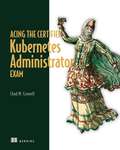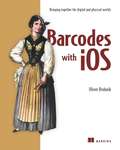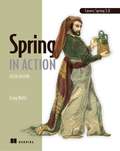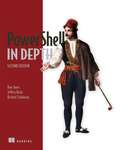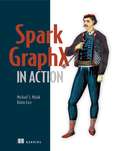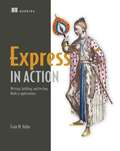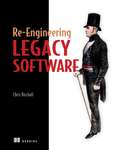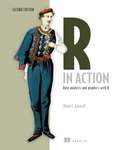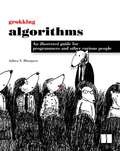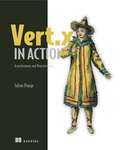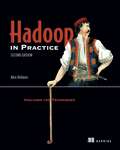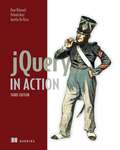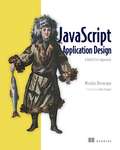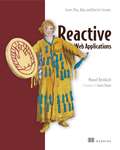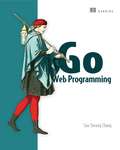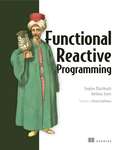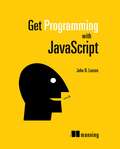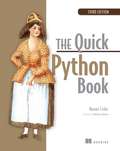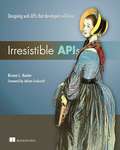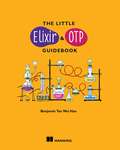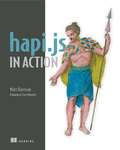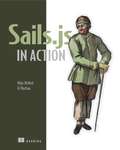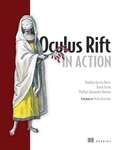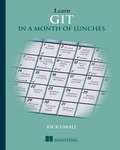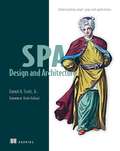- Table View
- List View
Acing the Certified Kubernetes Administrator Exam
by Chad CrowellBecoming a Kubernetes administrator is a big accomplishment—and passing the Certified Kubernetes Administrator (CKA) exam can be a big boost to your career! Learn the hands on skills you need to ace the exam with clear teaching and hands-on exercises that match the unique CKA test environment.In Acing the Certified Kubernetes Administrator Exam you&’ll learn how to: Administer an application running on Kubernetes Troubleshoot errors inside a Kubernetes cluster Authenticate users and machines to the Kubernetes API Create persistent storage in Kubernetes Add additional functionality to an existing Kubernetes cluster Acing the Certified Kubernetes Administrator Exam is your fast-track to becoming a Certified Kubernetes Administrator! Your expert exam tutor is Chad Crowell, whose courses have helped thousands of developers to understand Kubernetes and earn the coveted CKA certification. If you&’re familiar with Kubernetes, this book will ensure you&’re ready to pass in just one month of study. If you&’re brand new, this is the perfect primer to get started on your Kubernetes journey. Go hands-on with all the exam objectives, including deploying containerized applications to Kubernetes, accessing an application from an ingress resource, and backup and restore. Plus, essential exam tips and exercises help you work out your mental muscle memory. About the technology The Certified Kubernetes Administrator (CKA) exam proves to your next employer that you can set up and manage Kubernetes clusters. In this rigorous test offered by the Linux Foundation, you&’ll configure and manage production-grade clusters hands-on as a proctor watches. Simply put, if you aren&’t ready, you won&’t pass. About the book Acing the Certified Kubernetes Administrator Exam teaches every skill you need to pass the CKA. You can&’t &“hack&” this exam by learning a few test-taking tricks. Instead, you&’ll master vital techniques like load balancing and networking with carefully designed exercises that you practice using the CKA&’s command-line interface. With this book, you&’ll be confident and ready for exam day. What's inside Administer an application on Kubernetes Troubleshoot errors in a Kubernetes cluster Authenticate users and machines Create persistent storage About the reader For readers who know the basics of containers and Linux admin. No Kubernetes experience required. About the author Chad M. Crowell is the author of dozens of courses on Kubernetes and DevOps with Pluralsight and INE. Chad is also a Microsoft Certified Trainer (MCT). Table of Contents 1 First steps 2 Kubernetes cluster 3 Identity and access management 4 Deploying applications in Kubernetes 5 Running applications in Kubernetes 6 Communication in a Kubernetes cluster 7 Storage in Kubernetes 8 Troubleshooting Kubernetes 9 Taking the test
Barcodes with iOS: Bringing together the digital and physical worlds
by Oliver DrobnikSummaryBarcodes with iOS is the first and only book that comprehensively addresses barcode technology for the iOS developer. It offers an introduction to commonly used formats, such as ISBN and UPC codes, and provides real-world examples that teach you how to integrate code scanning and generation into your apps. This book consolidates information about applicable Apple frameworks in one place so you can quickly add native barcode support to your existing enterprise apps or start building new apps that help bring together the physical and digital worlds.Purchase of the print book includes a free eBook in PDF, Kindle, and ePub formats from Manning Publications.About the TechnologyBarcodes are a universal way to track and share information, appearing on everything from cereal boxes to shop windows. Starting with iOS 7, Apple has added native features for building apps that scan, display, and print barcodes, eliminating the need for third-party libraries.About the BookBarcodes with iOS teaches you how to effectively use barcodes in your iOS apps. You'll master Apple's new barcode frameworks while you explore real-world examples that integrate code scanning and generation and metadata retrieval into your apps. Along the way, you'll pick up numerous best practices for bringing together the physical and digital worlds.This book is written for readers with a working knowledge of Objective-C and iOS app development.What's InsideLearn about all barcode formats supported by iOSNative barcode scanning with AV FoundationUsing Core Image and BarCodeKit to produce a wide range of barcodesPrinting to sheets and labels with AirPrintRetrieving metadata for products with NSURLSession and NSURLProtocolHarnessing context information from Core Location and iBeaconsAbout the AuthorOliver Drobnik is an independent consultant specializing in custom iOS and Mac development.Table of ContentsBarcodes, iOS, and you 1Media capture with AV Foundation 18Scanning barcodes 48Passbook, Apple's digital wallet 70Generating barcodes 97Getting metadata for barcodes 133Putting barcodes in context 172AppendicesHistory of the UPC 205GTIN prefix ranges 212GS1-128 application identifiers 217
Spring in Action
by Craig WallsSummarySpring in Action, 5th Edition is the fully updated revision of Manning's bestselling Spring in Action. This new edition includes all Spring 5.0 updates, along with new examples on reactive programming, Spring WebFlux, and microservices. You'll also find the latest Spring best practices, including Spring Boot for application setup and configuration.Purchase of the print book includes a free eBook in PDF, Kindle, and ePub formats from Manning Publications.About the TechnologySpring Framework makes life easier for Java developers. New features in Spring 5 bring its productivity-focused approach to microservices, reactive development, and other modern application designs. With Spring Boot now fully integrated, you can start even complex projects with minimal configuration code. And the upgraded WebFlux framework supports reactive apps right out of the box!About the BookSpring in Action, 5th Edition guides you through Spring's core features, explained in Craig Walls' famously clear style. You'll roll up your sleeves and build a secure database-backed web app step by step. Along the way, you'll explore reactive programming, microservices, service discovery, RESTful APIs, deployment, and expert best practices. Whether you're just discovering Spring or leveling up to Spring 5.0, this Manning classic is your ticket!What's insideBuilding reactive applicationsSpring MVC for web apps and RESTful web servicesSecuring applications with Spring SecurityCovers Spring 5.0Over 100,000 copies sold!About the ReaderFor intermediate Java developers.About the AuthorCraig Walls is a principal software engineer at Pivotal, a popular author, an enthusiastic supporter of Spring Framework, and a frequent conference speaker.Table of ContentsPART 1 - FOUNDATIONAL SPRING Getting started with Spring Developing web applications Working with data Securing Spring Working with configuration properties PART 2 - INTEGRATED SPRINGCreating REST services Consuming REST services Sending messages asynchronously Integrating Spring PART 3 - REACTIVE SPRING Introducing Reactor Developing reactive APIs Persisting data reactivelyPART 4 CLOUD-NATIVE SPRINGDiscovering services Managing configuration Handling failure and latency PART 5 - DEPLOYED SPRING Working with Spring Boot Actuator Administering Spring Monitoring Spring with JMX Deploying Spring
PowerShell in Depth
by Don Jones Jeffery Hicks Richard SiddawaySummaryPowerShell in Depth, Second Edition is the go-to reference for administrators working with Windows PowerShell. Every major technique, technology, and tactic is carefully explained and demonstrated, providing a hands-on guide to almost everything an admin would do in the shell. Written by three experienced authors and PowerShell MVPs, this is the PowerShell book you'll keep next to your monitor—not on your bookshelf! Purchase of the print book includes a free eBook in PDF, Kindle, and ePub formats from Manning Publications.About the BookA Windows admin using PowerShell every day may not have the time to search the net every time he or she hits a snag. Wouldn't it be great to have a team of seasoned PowerShell experts ready to answer even the toughest questions? That's what you get with this book. PowerShell in Depth, Second Edition is the go-to reference for administrators working with Windows PowerShell. Every major technique, technology, and tactic is carefully explained and demonstrated, providing a hands-on guide to almost everything an admin would do in the shell. Written by PowerShell MVPs Don Jones, Jeffrey Hicks, and Richard Siddaway, each valuable technique was developed and thoroughly tested, so you'll be able to consistently write production-quality, maintainable scripts while saving hours of time and effort. This book assumes you know the basics of PowerShell. What's InsideAutomating tasksPackaging and deploying scriptsIntroduction to Desired State ConfigurationPowerShell securityCovers PowerShell version 3 and laterAbout the AuthorsDon Jones, Jeffery Hicks, and Richard Siddaway are Microsoft MVPs, trainers, and administrators. Collectively, they've authored nearly three dozen books on PowerShell and Windows administration.Table of ContentsPART 1 POWERSHELL FUNDAMENTALSIntroductionPowerShell hostsUsing the PowerShell help systemThe basics of PowerShell syntaxWorking with PSSnapins and modulesOperatorsWorking with objectsThe PowerShell pipelineFormattingPART 2 POWERSHELL MANAGEMENTPowerShell RemotingBackground jobs and schedulingWorking with credentialsRegular expressionsWorking with HTML and XML dataPSDrives and PSProvidersVariables, arrays, hash tables, and script blocksPowerShell securityAdvanced PowerShell syntaxPART 3 POWERSHELL SCRIPTING AND AUTOMATIONPowerShell's scripting languageBasic scripts and functionsCreating objects for outputScopePowerShell workflowsAdvanced syntax for scripts and functionsScript modules and manifest modulesCustom formatting viewsCustom type extensionsData language and internationalizationWriting helpError handling techniquesDebugging tools and techniquesFunctions that work like cmdletsTips and tricks for creating reportsPART 4 ADVANCED POWERSHELLWorking with the Component Object Model (COM) Working with .NET Framework objectsAccessing databasesProxy functionsBuilding a GUIWMI and CIMWorking with the webDesired State Configuration
Spark GraphX in Action
by Michael Malak Robin EastSummarySpark GraphX in Action starts out with an overview of Apache Spark and the GraphX graph processing API. This example-based tutorial then teaches you how to configure GraphX and how to use it interactively. Along the way, you'll collect practical techniques for enhancing applications and applying machine learning algorithms to graph data.Purchase of the print book includes a free eBook in PDF, Kindle, and ePub formats from Manning Publications.About the TechnologyGraphX is a powerful graph processing API for the Apache Spark analytics engine that lets you draw insights from large datasets. GraphX gives you unprecedented speed and capacity for running massively parallel and machine learning algorithms.About the BookSpark GraphX in Action begins with the big picture of what graphs can be used for. This example-based tutorial teaches you how to use GraphX interactively. You'll start with a crystal-clear introduction to building big data graphs from regular data, and then explore the problems and possibilities of implementing graph algorithms and architecting graph processing pipelines. Along the way, you'll collect practical techniques for enhancing applications and applying machine learning algorithms to graph data.What's InsideUnderstanding graph technologyUsing the GraphX APIDeveloping algorithms for big graphsMachine learning with graphsGraph visualizationAbout the ReaderReaders should be comfortable writing code. Experience with Apache Spark and Scala is not required.About the AuthorsMichael Malak has worked on Spark applications for Fortune 500 companies since early 2013. Robin East has worked as a consultant to large organizations for over 15 years and is a data scientist at Worldpay.Table of ContentsPART 1 SPARK AND GRAPHSTwo important technologies: Spark and graphsGraphX quick startSome fundamentalsPART 2 CONNECTING VERTICESGraphX BasicsBuilt-in algorithmsOther useful graph algorithmsMachine learningPART 3 OVER THE ARCThe missing algorithmsPerformance and monitoringOther languages and tools
Express in Action: Writing, building, and testing Node.js applications
by Evan HahnSummaryExpress in Action is a carefully designed tutorial that teaches you how to build web applications using Node and Express.Purchase of the print book includes a free eBook in PDF, Kindle, and ePub formats from Manning Publications.About the TechnologyExpress.js is a web application framework for Node.js. Express organizes your server-side JavaScript into testable, maintainable modules. It provides a powerful set of features to efficiently manage routes, requests, and views along with beautiful boilerplate for your web applications. Express helps you concentrate on what your application does instead of managing time-consuming technical details.About the BookExpress in Action teaches you how to build web applications using Node and Express. It starts by introducing Node's powerful traits and shows you how they map to the features of Express. You'll explore key development techniques, meet the rich ecosystem of companion tools and libraries, and get a glimpse into its inner workings. By the end of the book, you'll be able to use Express to build a Node app and know how to test it, hook it up to a database, and automate the dev process. What's InsideSimplify Node app setup with ExpressTesting Express applicationsUse Express for easy access to Node featuresData storage with MongoDBCovers Express 4 and Express 5 alphaAbout the ReaderTo get the most out of this book, you'll need to know the basics of web application design and be proficient with JavaScript.About the AuthorEvan Hahn is an active member of the Node and Express community and contributes to many open source JavaScript projects.Table of ContentsPART 1 INTROWhat is Express?The basics of Node.jsFoundations of ExpressPART 2 COREMiddlewareRoutingBuilding APIsViews and templates: Pug and EJSPART 3 EXPRESS IN CONTEXTPersisting your data with MongoDBTesting Express applicationsSecurityDeployment: assets and HerokuBest practices
Re-Engineering Legacy Software
by Chris BirchallSummaryAs a developer, you may inherit projects built on existing codebases with design patterns, usage assumptions, infrastructure, and tooling from another time and another team. Fortunately, there are ways to breathe new life into legacy projects so you can maintain, improve, and scale them without fighting their limitations.Purchase of the print book includes a free eBook in PDF, Kindle, and ePub formats from Manning Publications.About the BookRe-Engineering Legacy Software is an experience-driven guide to revitalizing inherited projects. It covers refactoring, quality metrics, toolchain and workflow, continuous integration, infrastructure automation, and organizational culture. You'll learn techniques for introducing dependency injection for code modularity, quantitatively measuring quality, and automating infrastructure. You'll also develop practical processes for deciding whether to rewrite or refactor, organizing teams, and convincing management that quality matters. Core topics include deciphering and modularizing awkward code structures, integrating and automating tests, replacing outdated build systems, and using tools like Vagrant and Ansible for infrastructure automation. What's InsideRefactoring legacy codebasesContinuous inspection and integrationAutomating legacy infrastructureNew tests for old codeModularizing monolithic projectsAbout the ReaderThis book is written for developers and team leads comfortable with an OO language like Java or C#.About the AuthorChris Birchall is a senior developer at the Guardian in London, working on the back-end services that power the website.Table of ContentsPART 1 GETTING STARTEDUnderstanding the challenges of legacy projects Finding your starting pointPART 2 REFACTORING TO IMPROVE THE CODEBASEPreparing to refactorRefactoringRe-architectingThe Big RewritePART 3 BEYOND REFACTORING—IMPROVING PROJECT WORKFLOWAND INFRASTRUCTUREAutomating the development environmentExtending automation to test, staging, and production environmentsModernizing the development, building, and deployment of legacy softwareStop writing legacy code!
R in Action: Data analysis and graphics with R
by Robert I. KabacoffSummaryR in Action, Second Edition presents both the R language and the examples that make it so useful for business developers. Focusing on practical solutions, the book offers a crash course in statistics and covers elegant methods for dealing with messy and incomplete data that are difficult to analyze using traditional methods. You'll also master R's extensive graphical capabilities for exploring and presenting data visually. And this expanded second edition includes new chapters on time series analysis, cluster analysis, and classification methodologies, including decision trees, random forests, and support vector machines.Purchase of the print book includes a free eBook in PDF, Kindle, and ePub formats from Manning Publications.About the TechnologyBusiness pros and researchers thrive on data, and R speaks the language of data analysis. R is a powerful programming language for statistical computing. Unlike general-purpose tools, R provides thousands of modules for solving just about any data-crunching or presentation challenge you're likely to face. R runs on all important platforms and is used by thousands of major corporations and institutions worldwide.About the BookR in Action, Second Edition teaches you how to use the R language by presenting examples relevant to scientific, technical, and business developers. Focusing on practical solutions, the book offers a crash course in statistics, including elegant methods for dealing with messy and incomplete data. You'll also master R's extensive graphical capabilities for exploring and presenting data visually. And this expanded second edition includes new chapters on forecasting, data mining, and dynamic report writing.What's InsideComplete R language tutorialUsing R to manage, analyze, and visualize dataTechniques for debugging programs and creating packagesOOP in ROver 160 graphsAbout the AuthorDr. Rob Kabacoff is a seasoned researcher and teacher who specializes in data analysis. He also maintains the popular Quick-R website at statmethods.net.Table of ContentsPART 1 GETTING STARTEDIntroduction to RCreating a datasetGetting started with graphsBasic data managementAdvanced data managementPART 2 BASIC METHODSBasic graphsBasic statisticsPART 3 INTERMEDIATE METHODSRegressionAnalysis of variancePower analysisIntermediate graphsResampling statistics and bootstrappingPART 4 ADVANCED METHODSGeneralized linear modelsPrincipal components and factor analysisTime seriesCluster analysisClassificationAdvanced methods for missing dataPART 5 EXPANDING YOUR SKILLSAdvanced graphics with ggplot2Advanced programmingCreating a packageCreating dynamic reportsAdvanced graphics with the lattice package available online only from manning.com/kabacoff2
Grokking Algorithms: An illustrated guide for programmers and other curious people
by Aditya BhargavaSummaryGrokking Algorithms is a fully illustrated, friendly guide that teaches you how to apply common algorithms to the practical problems you face every day as a programmer. You'll start with sorting and searching and, as you build up your skills in thinking algorithmically, you'll tackle more complex concerns such as data compression and artificial intelligence. Each carefully presented example includes helpful diagrams and fully annotated code samples in Python.Learning about algorithms doesn't have to be boring! Get a sneak peek at the fun, illustrated, and friendly examples you'll find in Grokking Algorithms on Manning Publications' YouTube channel.Continue your journey into the world of algorithms with Algorithms in Motion, a practical, hands-on video course available exclusively at Manning.com (www.manning.com/livevideo/algorithms-in-motion).Purchase of the print book includes a free eBook in PDF, Kindle, and ePub formats from Manning Publications.About the TechnologyAn algorithm is nothing more than a step-by-step procedure for solving a problem. The algorithms you'll use most often as a programmer have already been discovered, tested, and proven. If you want to understand them but refuse to slog through dense multipage proofs, this is the book for you. This fully illustrated and engaging guide makes it easy to learn how to use the most important algorithms effectively in your own programs.About the BookGrokking Algorithms is a friendly take on this core computer science topic. In it, you'll learn how to apply common algorithms to the practical programming problems you face every day. You'll start with tasks like sorting and searching. As you build up your skills, you'll tackle more complex problems like data compression and artificial intelligence. Each carefully presented example includes helpful diagrams and fully annotated code samples in Python. By the end of this book, you will have mastered widely applicable algorithms as well as how and when to use them.What's InsideCovers search, sort, and graph algorithmsOver 400 pictures with detailed walkthroughsPerformance trade-offs between algorithmsPython-based code samplesAbout the ReaderThis easy-to-read, picture-heavy introduction is suitable for self-taught programmers, engineers, or anyone who wants to brush up on algorithms.About the AuthorAditya Bhargava is a Software Engineer with a dual background in Computer Science and Fine Arts. He blogs on programming at adit.io.Table of ContentsIntroduction to algorithmsSelection sortRecursionQuicksortHash tablesBreadth-first searchDijkstra's algorithmGreedy algorithmsDynamic programmingK-nearest neighbors
Vert.x in Action: Asynchronous and Reactive Java
by Julien PongeVert.x in Action teaches you how to build production-quality reactive applications in Java. This book covers core Vert.x concepts, as well as the fundamentals of asynchronous and reactive programming. Learn to develop microservices by using Vert.x tools for database communications, persistent messaging, and test app resiliency. The patterns and techniques included here transfer to reactive technologies and frameworks beyond Vert.x.Summary As enterprise applications become larger and more distributed, new architectural approaches like reactive designs, microservices, and event streams are required knowledge. The Vert.x framework provides a mature, rock-solid toolkit for building reactive applications using Java, Kotlin, or Scala. Vert.x in Action teaches you to build responsive, resilient, and scalable JVM applications with Vert.x using well-established reactive design patterns. Purchase of the print book includes a free eBook in PDF, Kindle, and ePub formats from Manning Publications. About the technology Vert.x is a collection of libraries for the Java virtual machine that simplify event-based and asynchronous programming. Vert.x applications handle tedious tasks like asynchronous communication, concurrent work, message and data persistence, plus they&’re easy to scale, modify, and maintain. Backed by the Eclipse Foundation and used by Red Hat and others, this toolkit supports code in a variety of languages. About the book Vert.x in Action teaches you how to build production-quality reactive applications in Java. This book covers core Vert.x concepts, as well as the fundamentals of asynchronous and reactive programming. Learn to develop microservices by using Vert.x tools for database communications, persistent messaging, and test app resiliency. The patterns and techniques included here transfer to reactive technologies and frameworks beyond Vert.x. What's inside Building reactive services Responding to external service failures Horizontal scaling Vert.x toolkit architecture and Vert.x testing Deploying with Docker and Kubernetes About the reader For intermediate Java web developers. About the author Julien Ponge is a principal software engineer at Red Hat, working on the Eclipse Vert.x project. Table of Contents PART 1 - FUNDAMENTALS OF ASYNCHRONOUS PROGRAMMING WITH VERT.X 1 Vert.x, asynchronous programming, and reactive systems 2 Verticles: The basic processing units of Vert.x 3 Event bus: The backbone of a Vert.x application 4 Asynchronous data and event streams 5 Beyond callbacks 6 Beyond the event bus PART 2 - DEVELOPING REACTIVE SERVICES WITHT VERT.X 7 Designing a reactive application 8 The web stack 9 Messaging and event streaming with Vert.x 10 Persistent state management with databases 11 End-to-end real-time reactive event processing 12 Toward responsiveness with load and chaos testing 13 Final notes: Container-native Vert.x
Hadoop in Practice
by Alex HolmesSummaryHadoop in Practice, Second Edition provides over 100 tested, instantly useful techniques that will help you conquer big data, using Hadoop. This revised new edition covers changes and new features in the Hadoop core architecture, including MapReduce 2. Brand new chapters cover YARN and integrating Kafka, Impala, and Spark SQL with Hadoop. You'll also get new and updated techniques for Flume, Sqoop, and Mahout, all of which have seen major new versions recently. In short, this is the most practical, up-to-date coverage of Hadoop available anywhere.Purchase of the print book includes a free eBook in PDF, Kindle, and ePub formats from Manning Publications.About the BookIt's always a good time to upgrade your Hadoop skills! Hadoop in Practice, Second Edition provides a collection of 104 tested, instantly useful techniques for analyzing real-time streams, moving data securely, machine learning, managing large-scale clusters, and taming big data using Hadoop. This completely revised edition covers changes and new features in Hadoop core, including MapReduce 2 and YARN. You'll pick up hands-on best practices for integrating Spark, Kafka, and Impala with Hadoop, and get new and updated techniques for the latest versions of Flume, Sqoop, and Mahout. In short, this is the most practical, up-to-date coverage of Hadoop available.Readers need to know a programming language like Java and have basic familiarity with Hadoop.What's InsideThoroughly updated for Hadoop 2How to write YARN applicationsIntegrate real-time technologies like Storm, Impala, and SparkPredictive analytics using Mahout and RR Readers need to know a programming language like Java and have basic familiarity with Hadoop. About the AuthorAlex Holmes works on tough big-data problems. He is a software engineer, author, speaker, and blogger specializing in large-scale Hadoop projects.Table of ContentsPART 1 BACKGROUND AND FUNDAMENTALSHadoop in a heartbeatIntroduction to YARNPART 2 DATA LOGISTICSData serialization—working with text and beyondOrganizing and optimizing data in HDFSMoving data into and out of HadoopPART 3 BIG DATA PATTERNSApplying MapReduce patterns to big dataUtilizing data structures and algorithms at scaleTuning, debugging, and testingPART 4 BEYOND MAPREDUCESQL on Hadoop Writing a YARN application
jQuery in Action
by Bear Bibeault Aurelio De Rosa Yehuda KatzSummaryjQuery in Action, Third Edition, is a fast-paced and complete guide to jQuery, focused on the tasks you'll face in nearly any web dev project. Written for readers with minimal JavaScript experience, this revised edition adds new examples and exercises, along with the deep and practical coverage you expect from an In Action book. You'll learn how to traverse HTML documents, handle events, perform animations, write plugins, and even unit test your code. The unique lab pages anchor each concept with real-world code. Several new chapters teach you how to interact with other tools and frameworks to build modern single-page web applications.Purchase of the print book includes a free eBook in PDF, Kindle, and ePub formats from Manning Publications.About the TechnologyThanks to jQuery, no one remembers the bad old days when programmers manually managed browser inconsistencies, CSS selectors support, and DOM navigation, and when every animation was a frustrating exercise in raw JavaScript. The elegant, intuitive jQuery library beautifully manages these concerns, and jQuery 3 adds even more features to make your life as a web developer smooth and productive.About the BookjQuery in Action, Third Edition, is a fast-paced guide to jQuery, focused on the tasks you'll face in nearly any web dev project. In it, you'll learn how to traverse the DOM, handle events, perform animations, write jQuery plugins, perform Ajax requests, and even unit test your code. Its unique Lab Pages anchor each concept in real-world code. This expanded Third Edition adds new chapters that teach you how to interact with other tools and frameworks and build modern single-page web applications.What's InsideUpdated for jQuery 3DOM manipulation and event handlingAnimations and effectsAdvanced topics including Unit Testing and PromisesPractical examples and labsAbout the ReadersReaders are assumed to have only beginning-level JavaScript knowledge.About the AuthorsBear Bibeault is coauthor of Secrets of the JavaScript Ninja, Ajax in Practice, and Prototype and Scriptaculous in Action. Yehuda Katz is an early contributor to jQuery and cocreator of Ember.js. Aurelio De Rosa is a full-stack web developer and a member of the jQuery content team.Table of ContentsPART 1 STARTING WITH JQUERYIntroducing jQueryPART 2 CORE JQUERYSelecting elementsOperating on a jQuery collectionWorking with properties, attributes, and dataBringing pages to life with jQueryEvents are where it happens!Demo: DVD discs locatorEnergizing pages with animations and effectsBeyond the DOM with jQuery utility functionsTalk to the server with Ajax 260Demo: an Ajax-powered contact formPART 3 ADVANCED TOPICSWhen jQuery is not enough...plugins to the rescue!Avoiding the callback hell with DeferredUnit testing with QUnitHow jQuery fits into large projects
JavaScript Application Design: A Build First Approach
by Nicolas BevacquaSummaryJavaScript Application Design: A Build First Approach introduces JavaScript developers to techniques that will improve the quality of their software as well as their web development workflow. You'll begin by learning how to establish build processes that are appropriate for JavaScript-driven development. Then, you'll walk through best practices for productive day-to-day development, like running tasks when your code changes, deploying applications with a single command, and monitoring the state of your application once it's in production.Purchase of the print book includes a free eBook in PDF, Kindle, and ePub formats from Manning Publications.About the BookThe fate of most applications is often sealed before a single line of code has been written. How is that possible? Simply, bad design assures bad results. Good design and effective processes are the foundation on which maintainable applications are built, scaled, and improved. For JavaScript developers, this means discovering the tooling, modern libraries, and architectural patterns that enable those improvements.JavaScript Application Design: A Build First Approach introduces techniques to improve software quality and development workflow. You'll begin by learning how to establish processes designed to optimize the quality of your work. You'll execute tasks whenever your code changes, run tests on every commit, and deploy in an automated fashion. Then you'll focus on designing modular components and composing them together to build robust applications.This book assumes readers understand the basics of JavaScript.What's InsideAutomated development, testing, and deployment processesJavaScript fundamentals and modularity best practicesModular, maintainable, and well-tested applicationsMaster asynchronous flows, embrace MVC, and design a REST APIAbout the AuthorNicolas Bevacqua is a freelance developer with a focus on modular JavaScript, build processes, and sharp design. He maintains a blog at ponyfoo.com.Table of ContentsPART 1 BUILD PROCESSESIntroduction to Build FirstComposing build tasks and flowsMastering environments and the development workflowRelease, deployment, and monitoringPART 2 MANAGING COMPLEXITYEmbracing modularity and dependency managementUnderstanding asynchronous flow control methods in JavaScriptLeveraging the Model-View-ControllerTesting JavaScript componentsREST API design and layered service architectures
Reactive Web Applications: Covers Play, Akka, and Reactive Streams
by Manuel BernhardtSummaryReactive Web Applications teaches web developers how to benefit from the reactive application architecture and presents hands-on examples using the Play framework.Purchase of the print book includes a free eBook in PDF, Kindle, and ePub formats from Manning Publications.About the TechnologyReactive applications build on top of components that communicate asynchronously as they react to user and system events. As a result, they become scalable, responsive, and fault-tolerant. Java and Scala developers can use the Play Framework and the Akka concurrency toolkit to easily implement reactive applications without building everything from scratch.About the BookReactive Web Applications teaches web developers how to benefit from the reactive application architecture and presents hands-on examples using Play, Akka, Scala, and Reactive Streams. This book starts by laying out the fundamentals required for writing functional and asynchronous applications and quickly introduces Play as a framework to handle the plumbing of your application. The book alternates between chapters that introduce reactive ideas (asynchronous programming with futures and actors, managing distributed state with CQRS) and practical examples that show you how to build these ideas into your applications.What's InsideReactive application architectureBasics of Play and AkkaExamples in ScalaFunctional and asynchronous programmingAbout Reader DescriptionFor readers comfortable programming with a higher-level language such as Java or C#, and who can read Scala code. No experience with Play or Akka needed.About the AuthorManuel Bernhardt is a passionate engineer, author, and speaker. As a consultant, he guides companies through the technological and organizational transformation to distributed computing.Table of ContentsPART 1 GETTING STARTED WITH REACTIVE WEB APPLICATIONS Did you say reactive? Your first reactive web application Functional programming primer Quick introduction to Play PART 2 CORE CONCEPTSFutures Actors Dealing with state Responsive user interfacesPART 3 ADVANCED TOPICS Reactive Streams Deploying reactive Play applications Testing reactive web applications
Go Web Programming
by Sau Sheong ChangSummaryGo Web Programming teaches you how to build scalable, high-performance web applications in Go using modern design principles.Purchase of the print book includes a free eBook in PDF, Kindle, and ePub formats from Manning Publications.About the TechnologyThe Go language handles the demands of scalable, high-performance web applications by providing clean and fast compiled code, garbage collection, a simple concurrency model, and a fantastic standard library. It's perfect for writing microservices or building scalable, maintainable systems.About the BookGo Web Programming teaches you how to build web applications in Go using modern design principles. You'll learn how to implement the dependency injection design pattern for writing test doubles, use concurrency in web applications, and create and consume JSON and XML in web services. Along the way, you'll discover how to minimize your dependence on external frameworks, and you'll pick up valuable productivity techniques for testing and deploying your applications.What's InsideBasicsTesting and benchmarkingUsing concurrencyDeploying to standalone servers, PaaS, and DockerDozens of tips, tricks, and techniquesAbout the ReaderThis book assumes you're familiar with Go language basics and the general concepts of web development.About the AuthorSau Sheong Chang is Managing Director of Digital Technology at Singapore Power and an active contributor to the Ruby and Go communities.Table of ContentsPART 1 GO AND WEB APPLICATIONSGo and web applications Go ChitChat PART 2 BASIC WEB APPLICATIONSHandling requests Processing requests Displaying content Storing data PART 3 BEING REALGo web services Testing your application Leveraging Go concurrency Deploying Go
Functional Reactive Programming
by Stephen BlackheathSummaryFunctional Reactive Programming teaches the concepts and applications of FRP. It offers a careful walk-through of core FRP operations and introduces the concepts and techniques you'll need to use FRP in any language.Purchase of the print book includes a free eBook in PDF, Kindle, and ePub formats from Manning Publications.About the TechnologyToday's software is shifting to more asynchronous, event-based solutions. For decades, the Observer pattern has been the go-to event infrastructure, but it is known to be bug-prone. Functional reactive programming (FRP) replaces Observer, radically improving the quality of event-based code.About the BookFunctional Reactive Programming teaches you how FRP works and how to use it. You'll begin by gaining an understanding of what FRP is and why it's so powerful. Then, you'll work through greenfield and legacy code as you learn to apply FRP to practical use cases. You'll find examples in this book from many application domains using both Java and JavaScript. When you're finished, you'll be able to use the FRP approach in the systems you build and spend less time fixing problems. What's InsideThink differently about data and eventsFRP techniques for Java and JavaScriptEliminate Observer one listener at a timeExplore Sodium, RxJS, and Kefir.js FRP systemsAbout the ReaderReaders need intermediate Java or JavaScript skills. No experience with functional programming or FRP required.About the AuthorsStephen Blackheath and Anthony Jones are experienced software developers and the creators of the Sodium FRP library for multiple languages. Foreword by Heinrich Apfelmus. Illustrated by Duncan Hill.Table of ContentsStop listening! Core FRP Some everyday widget stuff Writing a real application New concepts FRP on the web Switch Operational primitives Continuous time Battle of the paradigms Programming in the real world Helpers and patterns Refactoring Adding FRP to existing projects Future directions
Get Programming with JavaScript
by John LarsenSummaryGet Programming with JavaScript is a hands-on introduction to programming for readers who have never programmed. You'll be writing your own web apps, games, and programs in no time! Foreword by Remy Sharp.Purchase of the print book includes a free eBook in PDF, Kindle, and ePub formats from Manning Publications.About the BookAre you ready to start writing your own web apps, games, and programs? You’re in the right place! Get Programming with JavaScript is a hands-on introduction to programming for readers who have never written a line of code. Since you’re just getting started, this friendly book offers you lots of examples backed by careful explanations. As you go along, you’ll find exercises to check your understanding and plenty of opportunities to practice your new skills. You don’t need anything special to follow the examples—just the text editor and web browser already installed on your computer. We even give you links to working online code so you can see how everything should look live on your screen.What’s InsideAll the basics—objects, functions, responding to users, and moreThink like a coder and design your own programsCreate a text-based adventure gameEnhance web pages with JavaScriptRun your programs in a web browserFour bonus chapters available onlineAbout the ReaderNo experience required! All you need is a web browser and an internet connection.About the AuthorJohn Larsen is a mathematics and computing teacher with an interest in educational research. He has an MA in mathematics and an MSc in information technology. He started programming in 1982, writing simple programs for teaching mathematics in 1993, building websites in 2001, and developing data-driven web-based applications for education in 2006.Table of ContentsPART 1 CORE CONCEPTS ON THE CONSOLEProgramming, JavaScript, and JS BinVariables: storing data in your programObjects: grouping your dataFunctions: code on demandArguments: passing data to functionsReturn values: getting data from functionsObject arguments: functions working with objectsArrays: putting data into listsConstructors: building objects with functionsBracket notation: flexible property namesPART 2 ORGANIZING YOUR PROGRAMSScope: hiding informationConditions: choosing code to runModules: breaking a program into piecesModels: working with dataViews: displaying dataControllers: linking models and viewsPART 3 JAVASCRIPT IN THE BROWSERHTML: building web pagesControls: getting user inputTemplates: filling placeholders with dataXHR: loading dataConclusion: get programming with JavaScriptBONUS ONLINE CHAPTERSNode: running JavaScript outside the browserExpress: building an APIPolling: repeating requests with XHRSocket.IO: real-time messaging
The Quick Python Book
by Naomi CederSummary This third revision of Manning's popular The Quick Python Book offers a clear, crisp updated introduction to the elegant Python programming language and its famously easy-to-read syntax. Written for programmers new to Python, this latest edition includes new exercises throughout. It covers features common to other languages concisely, while introducing Python's comprehensive standard functions library and unique features in detail. Foreword by Nicholas Tollervey, Python Software Foundation. Purchase of the print book includes a free eBook in PDF, Kindle, and ePub formats from Manning Publications. About the Technology Initially Guido van Rossum's 1989 holiday project, Python has grown into an amazing computer language. It's a joy to learn and read, and powerful enough to handle everything from low-level system resources to advanced applications like deep learning. Elegantly simple and complete, it also boasts a massive ecosystem of libraries and frameworks. Python programmers are in high demand/mdash;you can't afford not to be fluent! About the Book The Quick Python Book, Third Edition is a comprehensive guide to the Python language by a Python authority, Naomi Ceder. With the personal touch of a skilled teacher, she beautifully balances details of the language with the insights and advice you need to handle any task. Extensive, relevant examples and learn-by-doing exercises help you master each important concept the first time through. Whether you're scraping websites or playing around with nested tuples, you'll appreciate this book's clarity, focus, and attention to detail. What's Inside Clear coverage of Python 3 Core libraries, packages, and tools In-depth exercises Five new data science-related chapters About the Reader Written for readers familiar with programming concepts--no Python experience assumed. About the Author Naomi Ceder is chair of the Python Software Foundation. She has been learning, using, and teaching Python since 2001. Table of Contents PART 1 - STARTING OUT 1. About Python 2. Getting started 3. The Quick Python overview PART 2 - THE ESSENTIALS 4. The absolute basics 5. Lists, tuples, and sets 6. Strings 7. Dictionaries 8. Control flow 9. Functions 10. Modules and scoping rules 11. Python programs 12. Using the filesystem 13. Reading and writing files 14. Exceptions PART 3 - ADVANCED LANGUAGE FEATURES 15. Classes and object-oriented programming 16. Regular expressions 17. Data types as objects 18. Packages 19. Using Python libraries PART 4 - WORKING WITH DATA 20. Basic file wrangling 21. Processing data files 22. Data over the network 23. Saving data 24. Exploring data
Irresistible APIs: Designing web APIs that developers will love
by Kirsten HunterSummaryA Web API is a platform with a web-style interface developers can use to implement functionality. Well-designed APIs feel like a natural extension of the application, rather than just a new interface into the backend database. Designing Web APIs based on use cases allows an organization to develop irresistible APIs, which developers can consume easily and which support the business values of that organization.Purchase of the print book includes a free eBook in PDF, Kindle, and ePub formats from Manning Publications.About the TechnologyIt takes a village to deliver an irresistible web API. Business stakeholders look for an API that works side-by-side with the main product to enhance the experience for customers. Project managers require easy integration with other products or ways for customers to interact with your system. And, developers need APIs to consistently interoperate with external systems. The trick is getting the whole village together. This book shows you how.About the BookIrresistible APIspresents a process to create APIs that succeed for all members of the team. In it, you'll learn how to capture an application's core business value and extend it with an API that will delight the developers who use it. Thinking about APIs from the business point of view, while also considering the end-user experience, encourages you to explore both sides of the design process and learn some successful biz-to-dev communication patterns. Along the way, you'll start to view your APIs as part of your product's core value instead of just an add-on.What's InsideDesign-driven developmentDeveloping meaningful use casesAPI guiding principlesHow to recognize successful APIsAbout the ReaderWritten for all members of an API design team, regardless of technical level.About the AuthorKirsten Hunter is an API evangelist who helps developers and business stakeholders understand, design, and deliver amazing APIs.Table of ContentsUNDERSTANDING WEB APIsWhat makes an API irresistible?Working with web APIsAPI FirstWeb services explainedDESIGNING WEB APIsGuiding principles for API designDefining the value for your APICreating your schema modelDesign-driven developmentEmpowering your developers
The Little Elixir & OTP Guidebook
by Benjamin Tan Wei HaoSummaryThe Little Elixir & OTP Guidebook gets you started programming applications with Elixir and OTP. You begin with a quick overview of the Elixir language syntax, along with just enough functional programming to use it effectively. Then, you'll dive straight into OTP and learn how it helps you build scalable, fault-tolerant and distributed applications through several fun examples. Purchase of the print book includes a free eBook in PDF, Kindle, and ePub formats from Manning Publications.About the TechnologyElixir is an elegant programming language that combines the expressiveness of Ruby with the concurrency and fault-tolerance of Erlang. It makes full use of Erlang's BEAM VM and OTP library, so you get two decades' worth of maturity and reliability right out of the gate. Elixir's support for functional programming makes it perfect for modern event-driven applications.About the BookThe Little Elixir & OTP Guidebook gets you started writing applications with Elixir and OTP. You'll begin with the immediately comfortable Elixir language syntax, along with just enough functional programming to use it effectively. Then, you'll dive straight into several lighthearted examples that teach you to take advantage of the incredible functionality built into the OTP library. What's InsideCovers Elixir 1.2 and 1.3Introduction to functional concurrency with actorsExperience the awesome power of Erlang and OTP About the ReaderWritten for readers comfortable with a standard programming language like Ruby, Java, or Python. FP experience is helpful but not required. About the AuthorBenjamin Tan Wei Hao is a software engineer at Pivotal Labs, Singapore. He is also an author, a speaker, and an early adopter of Elixir.Table of ContentsGETTING STARTED WITH ELIXIR AND OTPIntroduction A whirlwind tour Processes 101 Writing server applications with GenServer FAULT TOLERANCE, SUPERVISION, AND DISTRIBUTION Concurrent error-handling and fault tolerance with links, monitors, and processes Fault tolerance with Supervisors Completing the worker-pool application Distribution and load balancing Distribution and fault tolerance Dialyzer and type specifications Property-based and concurrency testing
hapi.js in Action
by Matt HarrisonSummaryHapi.js in Action teaches you how to build modern Node-driven applications using hapi.js. Packed with examples, this book takes you from your first simple server through the skills you'll need to build a complete application. Foreword by Eran Hammer.Purchase of the print book includes a free eBook in PDF, Kindle, and ePub formats from Manning Publications.About the TechnologyThe hapi.js web framework for Node.js is built around three radical ideas. Developer productivity: hapi's intuitive setup gets you up and running in no time. Maintainability: hapi's modular design allows for easy scaling and improvement. Flexibility: hapi has a lightweight core that you can expand and customize with plugins. Are you ready to get hapi?About the BookHapi.js in Action is an incredibly practical book that teaches you to build APIs, servers, and applications using Node.js and the hapi.js framework. You'll begin with an easy-to-follow mental model of a Node.js web application and see exactly where hapi fits into the picture. Then, you'll walk through building an API and composing it into a web application. Along the way, you'll explore key topics like validation, testing, authentication, and deployment. Throughout, you'll learn how to build rock-solid, secure, and fast applications.What's InsideBest practices for Node application designBuilding APIs with hapiMaintaining and scaling applicationsExtending hapi with pluginsAbout the ReaderThis book assumes you have strong JavaScript skills. Experience with Node.js is helpful but not required.About the AuthorMatt Harrison is a core contributor to hapi.js and an active member of the Node community.Table of ContentsPART 1 - FIRST STEPSIntroducing hapiBuilding an APIBuilding a websitePART 2 - EXPANDING YOUR TOOLBOXRoutes and handlers in-depthUnderstanding requests and responsesValidation with JoiBuilding modular applications with pluginsCache me if you canPART 3 - CREATING ROCK-SOLID APPSAuthentication and securityTesting with Lab, Code, and server.inject()Production and beyond
Sails.js in Action
by Irl Nathan Michael McNeilSummarySails.js in Action is a comprehensive guide to buildingenterprise-capable web applications using Node and Sails. Written by the creators of the Sails.js framework, this book carefully introduces each concept, technique, and tool with real-world examples and crystal clear explanations.Purchase of the print book includes a free eBook in PDF, Kindle, and ePub formats from Manning Publications.About the TechnologySails makes professional web development a breeze. This instantly familiar MVC framework automatically handles the tedious application boilerplate, so you can concentrate on developing features and creating business value. You get powerful tools for rapid API development, task automation, an ORM, and easy integration with any web, mobile, or IoT frontend. And because you're using Node.js, it's JavaScript all the way down.About the BookSails.js in Action is a comprehensive guide on how to build enterprise-capable web applications. Written by the creators of Sails.js, this book introduces each concept and technique with real-world examples and thorough explanations. As you read, you'll learn to build the backend of a typical web application while you explore real-time programming with WebSockets, security fundamentals, and best practices for building Sails/Node.js apps.What's InsideCreating the backend for a web, mobile, or IoT appReal-time programming with WebSocketsUser management, authentication, and password recoveryUsing Sails to autogenerate REST APIsCustom backend development and third-party API integrations About the ReaderReaders should be comfortable with JavaScript and frontend web development. About the AuthorMike McNeil is the creator of Sails.js. Irl Nathan is the producer of sailsCasts, a series focused on using Sails.Table of ContentsGetting startedFirst stepsUsing static assetsUsing the blueprint APICustom backend codeUsing modelsCustom actionsServer-rendered viewsAuthentication and sessionsPolicies and access controlRefactoringEmbedded data and associationsRatings, followers, and searchRealtime with WebSocketsDeployment, testing, and security
Oculus Rift in Action
by Brad Davis Alex Benton Karen BrylaSummaryOculus Rift in Action introduces the powerful Oculus Rift headset and teaches you how to integrate its many features into 3D games and other virtual reality experiences. You'll start by understanding the capabilities of the Rift hardware. Then you'll follow interesting and instantly-relevant examples that walk you through programming real applications using the Oculus SDK. Examples are provided for both using the Oculus C API directly and for using Unity, a popular development and 3D graphics engine, with the Oculus Unity integration package.Purchase of the print book includes a free eBook in PDF, Kindle, and ePub formats from Manning Publications.About the BookVirtual reality has long been the domain of researchers and developers with access to specialized hardware and proprietary tools. With the appearance of the Oculus Rift VR headset, the game has changed. Using standard programming tools and the intuitive Oculus SDKs, you can deliver powerful immersive games, simulations, and other virtual experiences that finally nail the feeling of being in the middle of the action.Oculus Rift in Action teaches you how to create 3D games and other virtual reality experiences for the Oculus Rift. You'll explore the Rift hardware through examples of real applications using the Oculus SDK and both the Oculus C API and the Unity 3D graphics engine. Along the way, you'll get practical guidance on how to use the Rift's sensors to produce fluid VR experiences.Experience with C++, C#, or another OO language is assumed.What's InsideCreating immersive VRIntegrating the Rift with the Unity 3D SDKImplementing the mathematics of 3DAvoiding motion-sickness triggersAbout the AuthorsBrad Davis is an active VR developer who maintains a great set of example Rift applications on Github. Karen Bryla is a freelance developer and writer. Alex Benton is a lecturer in 3D graphics at the University of Cambridge and a software engineer at Google.Table of ContentsPART 1 GETTING STARTEDMeet the Oculus RiftPART 2 USING THE OCULUS C APICreating your first Rift interactionsPulling data out of the Rift: working with the head trackerSending output to the Rift: working with the displayPutting it all together: integrating head tracking and 3D renderingPerformance and qualityPART 3 USING UNITYUnity: creating applications that run on the RiftUnity: tailoring your application for the RiftPART 4 THE VR USER EXPERIENCEUI design for VRReducing motion sickness and discomfortPART 5 ADVANCED RIFT INTEGRATIONSUsing the Rift with Java and PythonCase study: a VR shader editorAugmenting virtual reality
Learn Git in a Month of Lunches
by Rick UmaliSummaryLearn Git in a Month of Lunches introduces the discipline of source code control using Git. Whether you're a newbie or a busy pro moving your source control to Git, you'll appreciate how this book concentrates on the components of Git you'll use every day. In easy-to-follow lessons designed to take an hour or less, you'll dig into Git's distributed collaboration model, along with core concepts like committing, branching, and merging.Purchase of the print book includes a free eBook in PDF, Kindle, and ePub formats from Manning Publications.About the BookGit is the source code control system preferred by modern development teams. Its decentralized architecture and lightning-fast branching let you concentrate on your code instead of tedious version control tasks. At first, Git may seem like a sprawling beast. Fortunately, to get started you just need to master a few essential techniques. Read on!Learn Git in a Month of Lunches introduces the discipline of source code control using Git. Helpful for both newbies who have never used source control and busy pros, this book concentrates on the components of Git you'll use every day. In easy-to-follow lessons that take an hour or less, you'll dig into Git's distributed collaboration model, along with core concepts like committing, branching, and merging. This book is a road map to the commands and processes you need to be instantly productive.What's InsideStart from square one—no experience requiredThe most frequently used Git commandsMental models that show how Git worksLearn when and how to branch codeAbout the ReaderNo previous experience with Git or other source control systems is required.About the AuthorRick Umali uses Git daily as a developer and is a skilled consultant, trainer, and speaker.Table of ContentsBefore you beginAn overview of Git and version controlGetting oriented with GitMaking and using a Git repositoryUsing Git with a GUITracking and updating files in GitCommitting parts of changesThe time machine that is GitTaking a fork in the roadMerging branchesCloningCollaborating with remotesPushing your changesKeeping in syncSoftware archaeologyUnderstanding git rebaseWorkflows and branching conventionsWorking with GitHubThird-party tools and GitSharpening your Git
SPA Design and Architecture: Understanding single-page web applications
by Emmit A. Scott, Jr.SummarySPA Design and Architecture teaches you the design and development skills you need to create SPAs. Includes an overview of MV* frameworks, unit testing, routing, layout management, data access, pub/sub, and client-side task automation. This book is full of easy-to-follow examples you can apply to the library or framework of your choice.Purchase of the print book includes a free eBook in PDF, Kindle, and ePub formats from Manning Publications.About the TechnologyThe next step in the development of web-based software, single-page web applications deliver the sleekness and fluidity of a native desktop application in a browser. If you're ready to make the leap from traditional web applications to SPAs, but don't know where to begin, this book will get you going.About the BookSPA Design and Architecture teaches you the design and development skills you need to create SPAs. You'll start with an introduction to the SPA model and see how it builds on the standard approach using linked pages. The author guides you through the practical issues of building an SPA, including an overview of MV* frameworks, unit testing, routing, layout management, data access, pub/sub, and client-side task automation. This book is full of easy-to-follow examples you can apply to the library or framework of your choice.What's InsideWorking with modular JavaScriptUnderstanding MV* frameworksLayout managementClient-side task automationTesting SPAsAbout the ReaderThis book assumes you are a web developer and know JavaScript basics.About the AuthorEmmit Scott is a senior software engineer and architect with experience building large-scale, web-based applications.Table of ContentsPART 1 THE BASICSWhat is a single-page application?The role of MV* frameworksModular JavaScriptPART 2 CORE CONCEPTSNavigating the single pageView composition and layoutInter-module interactionCommunicating with the serverUnit testingClient-side task automationAPPENDIXESEmployee directory example walk-throughReview of the XMLHttpRequest APIChapter 7 server-side setup and summaryInstalling Node.js and Gulp.js
